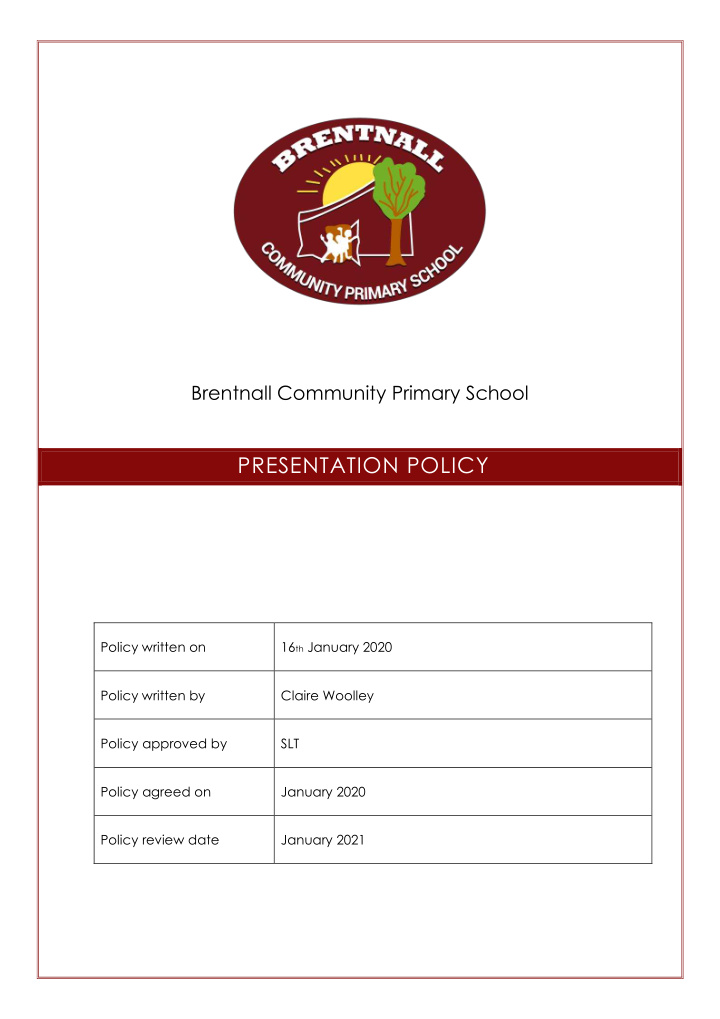



Brentnall Community Primary School PRESENTATION POLICY Policy written on 16 th January 2020 Policy written by Claire Woolley Policy approved by SLT Policy agreed on January 2020 Policy review date January 2021
RATIONALE Work, which is well presented, is attractive and easy to read. Children should be encouraged to take pride in what they do and always aim to do their best. AIMS AND OBJECTIVES • Teachers set high expectations for presentation • There is a consistent approach across the school • The policy will be regularly reinforced with children CHILDREN’S WORK Book covers should indicate: • Child’s full name • Year group • Subject • These should be printed on the school’s agreed book labels that are pre -printed for the school year ahead. They can also be found on the shared drive should additional labels be required throughout the year. • Children should not write on the covers of their books. Stickers will be made at the start of each academic year and should be stuck neatly, by the teacher, on the front of the children’s books. There will be more than one sticker for English and Maths books, that should be stored for when the children have completed a book. Date of work in books: Full written date in all books except Maths when the digital date will be appropriate. For younger children, teachers are encouraged to work towards this standard as soon as children are able. Date is left aligned and underlined with a ruler. Title of work in books: Children need to write the learning intentions in their books for each piece of work. Or for younger children, stick in a typed strip of paper prepared by the teacher. There should be a line gap between date and title. Titles should be centre aligned and underlined with a ruler. For younger children, teachers are encouraged to work towards this standard as soon as children are able. Finishing work: Children should not rule off on completion of a piece of work. Space should be left for teacher’s comments and children’s responses (Pink Pen Challenge). When starting a new piece of work, if there is more than half a side left following the teachers marking then children should be encouraged to rule off and start their next piece of work on the same side.
Handwriting In EYFS a “preparation” for handwriting approach is taken with a range of activities , including handwriting practise during RWI lessons. From Reception onwards, children should be given clear and specific guidance about letter formation, letter joining, and advice for left-handed writers. All children should write in pencil in their books until teachers are satisfied that they can consistently write in a fluent joined style. Children will be given a handwriting pen for use in their own work in school, except for Maths where all work must be completed in pencil. No other pens should be used. General presentation Children should use pencil crayons when illustrating work in books. Errors should be crossed out with a single pencil line. Children may use rubbers at the teachers’ discretion. Children should be taught how to set out Maths work appropriately. Numbers to questions / answers should be written in the margin (when available) All tables should be drawn with a ruler. Teachers should encourage a good standard of presentation overall. Children should not miss out lines unless drafting a piece of work. Paragraphs should be indented and lines should not be missed out (unless you are going to comment on each paragraph when marking) Appendix 1 and 2 of this document show examples of how both English and Maths learning should be set out in children’s books. TEACHING BOARDS (E.G. WHITEBOARDS AND INTERACTIVE WHITEBOARDS) Date: Full date and digital date – both underlined. Both dates left aligned. L.I: Starts with To… (To infer, etc.) Left aligned and underlined Handwriting: Teacher should model the appropriate handwriting style whenever they are writing for the class unless this mitigates against children’s ability to read the text
Interactive Whiteboards: A range of fonts can be used, as children will be exposed to them in books. However, it is important to ensure they are age appropriate and of a size that is clearly visible to/ readable by all children. DISPLAY There should be an appropriate emphasis on current English and Maths work on display in the classroom Displays should ha ve clear titles and children’s work should be named. It may be useful to display a short explanation of the learning alongside the display. The display policy is to be followed at all times to ensure consistency of colours/fonts etc. Displays should celebrate and reflect recent work. Teachers should ensure that displays celebrating work are changed regularly (at least termly). All subjects of the curriculum should be represented in displays. Where display space is limited, e.g. classrooms, displays in teaching areas should be used as tools for teaching and learning. Wherever possible children’s spelling should be correct and there should be no crossings out (other than on working walls).
Recommend
More recommend